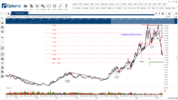Value Collector
Have courage, and be kind.
- Joined
- 13 January 2014
- Posts
- 12,260
- Reactions
- 8,512
I think what he means is that you might not be able to purchase more shares once you have deducted your Capital gains tax and trading costs.Back at the grind after a week of flu so pretty hectic.
Will answer when I can.
Peter what about the extra shares you would be able to purchase when re purchasing at the lower rate plus the extra dividends on the extra shares you would have.?
Think back to that CBA example, the guy that bought in at $5.40 and held, had his capital compounding away at 15%, for 30 years and never had to divert any of his funds away from his portfolio to pay taxes.
where as the guy that traded in and out, would have regularly had to divert funds away from his portfolio to pay taxes, not only missing out on the 50% CGT discount, but also sometimes missing out of franking credits due to the 45 day rule and sometimes missing dividends completely.
of course it is possible to still beat the buy and hold guy by trading if you manage to time your buys and sells Well.
But what Peter is pointing out is that where the Buy and Hold guy earned 15% per year, the trader would have to be earning at least 20% (30% more) per year to break even after taxes and trading costs.
it’s a point often missed, by delaying the Capital gains tax by holding long term, can allow you to essentially have those “tax dollars” continue growing and earning you dividends for decades before you have to end up handing them over to the government.


